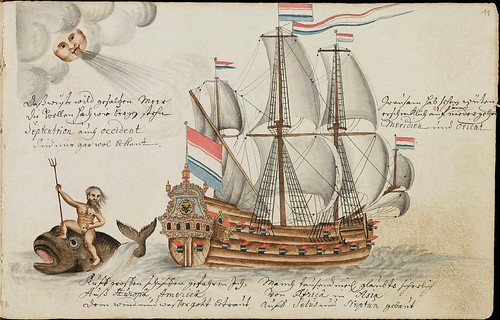
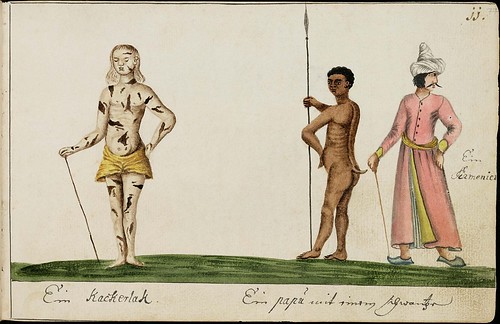
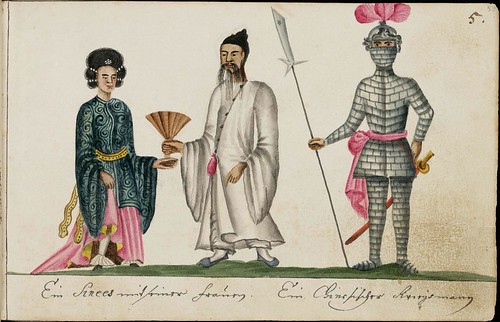
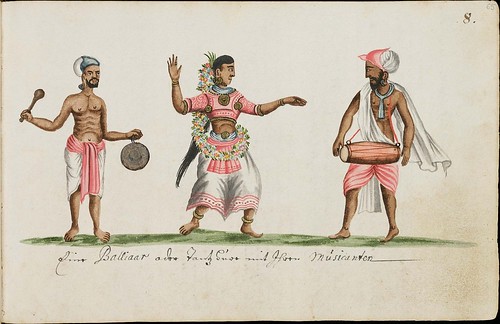
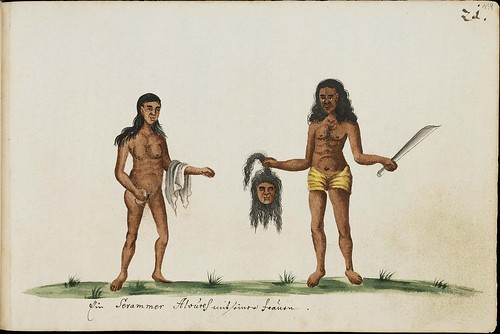
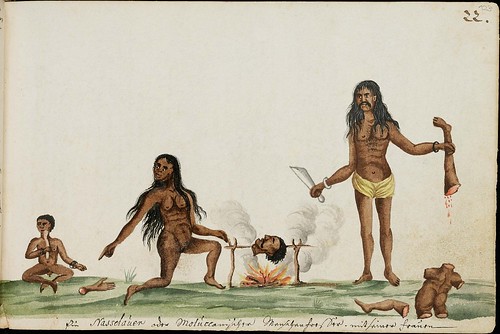
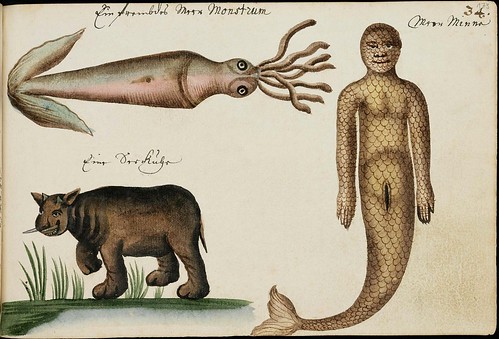
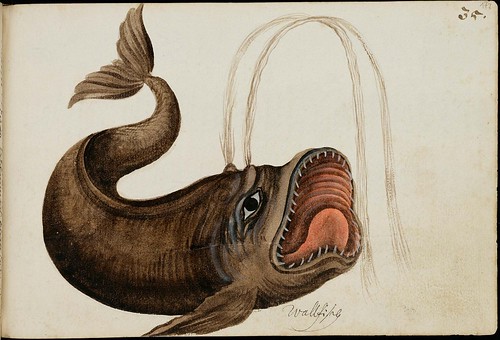
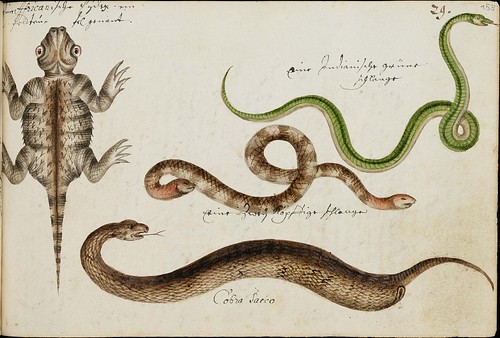

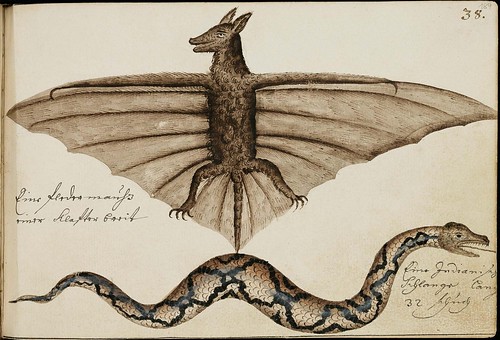
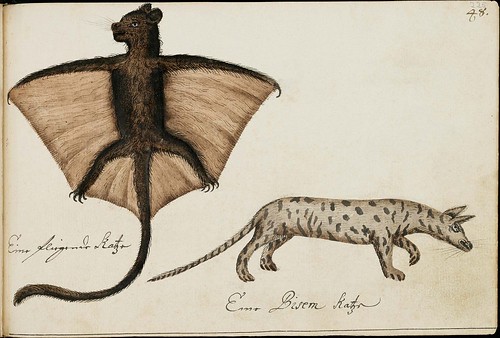
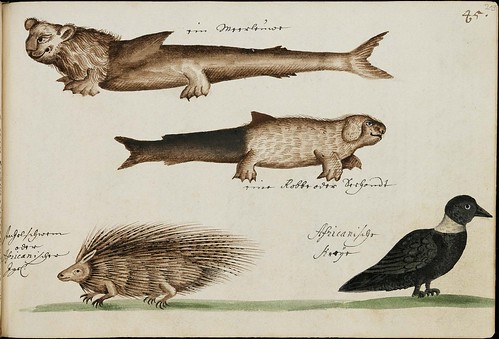
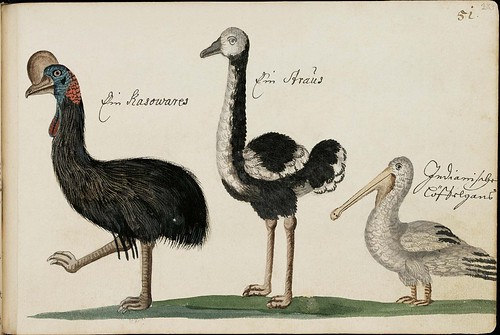



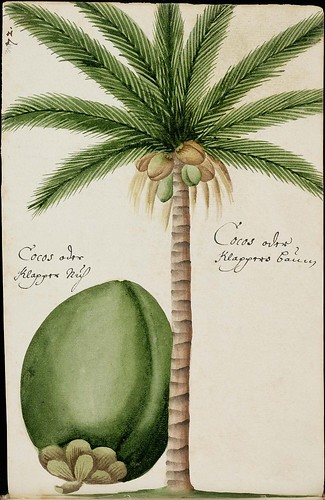
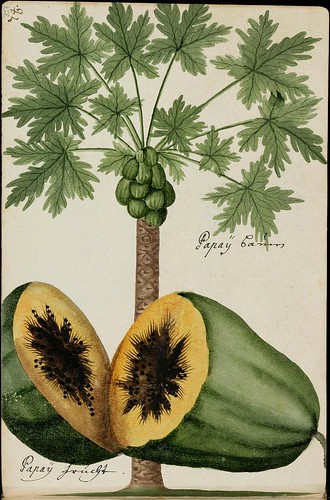
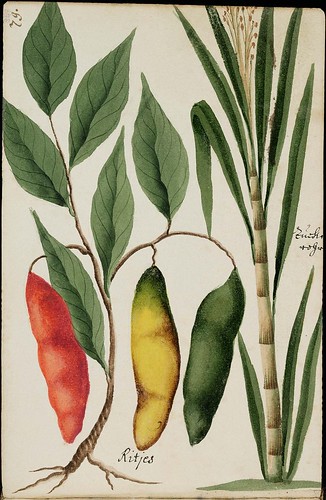

☼☼ Click through any picture for a greatly enlarged version. All the images have been extensively background cleaned according to the "less is more" and "when in doubt, don't" philosophies of restoration. ☼☼
These extraordinary illustrations come from one of two journals kept by a German recruit to the Dutch East India Company (VOC). Jörg Franz Müller was a gunsmith from Alsace who enlisted as a midshipman aboard VOC vessels that sailed between Europe and Batavia [in Indonesia] from 1669 to 1682.
The imaginative renderings of peoples, animals and plants from Asia and Africa make up for their lack of strict accuracy with an endearing naive style. It's likely that Müller had at least seen (if not attempted to reproduce drawings remembered from) some earlier natural history works containing fanciful creatures. Although there is little around in english online about this work, there is mention of Müller being aboard vessels taking exotic creatures in cages back to Holland, so he definitely had access to specimens.
- The journal from 1681 is entitled 'Georg Franz Müller von Ruffach Reise nach Batavia' [Cod. Sang. 1311] and is accessible from the excellent St. Gallen, Stiftsbibliothek e-codices site with huge page images available. {click the drop-down menu next to 'Anzeige' for a thumbnail matrix} St Gallen also own Müller's second journal but it hasn't been digitised as yet.
- The Dutch National Library has an html version (with images) of a book - 'Het Oost-Indisch avontuur. Duitsers in dienst van de voc (1600-1800)' - from 2006 by Roelof van Gelder about the German recruits to the VOC. Unfortunately it is only available in Dutch and the machine translations (as usual) are fairly abysmal.
- Thanks very much to Ortelius from Cavendum a Meretricibus for finding this gem of an album.
- Previously: Most of the posts listed under the Indonesia tag relate to the Dutch East Indies Company where further background and image sources are listed.



















16 comments :
They are indeed charming, although I was a little uncertain just what was genuinely Indonesian (no gamelan or puppets? admittedly those aren't natural history, but where in Indonesia were the cannibals found?) and how the cockatoo came to consort with the penguin. I suppose the latter was a matter of specimen-collecting.
We look forward to the digitization of the second journal.
I think you can find cannibals in Papua New Guinea.
Yes, I hadn't been thinking of the people there. They're still known for consumption of dead relatives, I believe.
The 'Batavia' in the title is a little misleading I guess. The cassowary is the most obvious 'nod' to New Guinea (beyond cannibals) and the fact that it's juxtaposed with an ostrich probably means that this so-called journal was more of a natural history sketch book rather than a true diary. Muller's name appears in that book linked above on many, many occasions but I gave up translating the citations when I couldn't work out whether they were suggesting his writings were accurate or inaccurate.
It's true that when I see 'Batavia' I think of Indonesia but the penguin should have made obvious Muller was around and about. I've seen my share of cassowaries in museums but I wouldn't have remembered them being from New Guinea. New Guinea makes me think more of inaccessibility to western explorers, and also of farming practices (not that I recall exactly what these were) that proved better for the terrain than those proposed by outside experts.
Comment deleted because of spammy link...
[Ashique said... "Superb Work and great findings, truly these pics are nice to watch but horrible in reality. Great post mate."]
Ashique, your erudition and keen insight give me hope for a better yesterday, always. Shine on you crazy beacon of insect attractant.
Although some of the creatures pictured come from New Guinea, it is unlikely the journey actually went there. They probably went to the Moluccas.
The caption of the 'second cannibal picture' is nearly unreadable, but the word 'Moluccas' stands out.
The cannibals in the first 'cannibal picture' are called 'Serammer Alvure': Ceram is a big island in the South Moluccas (close to the Dutch trading post Ambom). 'Alvure' (or Alfur, Alfura, Arafura), I believe to be a name for a 'wild' inhabitant of the interior. Up until the 1900's Papuans, too, were often called 'Alfur'.
I wonder about the white leper (?) in the second picture: why is he called 'ein kackerlak', a cockroach?
De la mano de " La Ciencia de la vida", paso a visitarse. Extraordinario rincón como estelares sus pinturas, felicidades, un saludo.
-Although some of the creatures pictured come from New Guinea, it is unlikely the journey actually went there.-
My Dutch is non-existent so I can't cite +/- argue but the VOC had definitely visited New Guinea by the time of this journal (the first map of the whole island was made in 1600 I believe). It's perhaps a moot point as it's easily possible that cassowaries had been taken westward to the Moluccas as you say. And I'm not sure if 'journey' ought to be singular. My feeling was that Muller was a sailor rather than a colonialist so I expect that in his 13 years with the VOC he was involved with a number of voyages.
You're right, my comment about Muller not having gone to New Guinea is somewhat unfounded: I did not read the diary. But I do know a thing or two about New Guinea's history, which make it somewhat unlikely. At the time of the VOC the Dutch did go to New Guinea: Jan Carstensz was the first (1620's) and Abel Tasman (1640's) passed by, there may have a handful more but not many. The VOC had decided against actually setting up shop in New Guinea: the Moluccans had traded with the Papuans for centuries and they effectively broke any Dutch attempt at circumventing them. Moreover the merchandise to be had there was not all that valuable anyway: mostly slaves, Massoi bark, very inferior wild nutmeg. In the 1660 'Eternal Treaty' between the Sultan of Tidore and the VOC, the 'Papoo islands' were included in the Sultan's domain and on this basis the VOC made sure no competitor went there. In other words, at the time of Muller any VOC expedition to New Guinea was merely going to check that the competitors (Brits, French) stayed away from these rather unwelcoming shores (only in the late 19th century Europeans successfully settled in New Guinea). Now Muller may have gone on one of these rare expeditions - I couldn't list them - but if he did it probably would not have lasted long: the Dutch feared these coasts.
But given the strong trade contacts between the Moluccas and New Guinea, Muller may just as easily have seen the Cassowary in the Moluccas: there was no need to actually visit New Guinea. There is a Papuan in one of the pictures ('ein Papu', note that he has a tail), next to 'ein Armenier' (an Armenian!), but that may just as easily have been a slave posed with a spear for the picture. The final reference to New Guinea I see is the hornbill bird, but that bird may may not be limited to New Guinea.
Many of the other reference are not to New Guinea at all: there is a 'Baliaan' (balinese) and a 'Sinees' (Chinese) - several of each actually. The Cerammers (Moluccans) I already noted.
The language of the text is more German than Dutch, BTW.
Oh, how rude of me! I forgot to thank the author of this blog. I am new, but I quite love what I see on here!
Fascinating. I'm still wondering about the kackerlak (I was also guessing maybe leprosy, but...?) and why the Papuan has a tail (was he one of the occasional humans who do or did the artist suppose Papuans generally do?).
Thanks very much Mark; I'm always happy to be educated. My mentioning of the Dutch language was really about the reference book linked above.
One other thing worth noting is the presence of the fabulous animals. I didn't try to track down the mermaid (merman?) figure or those 'dog-fish' but I suspect Gesner (mid-1500s) might be the ultimate inspiration [hard to say confidently because of so much reinterpretation & stealing etc]. I suggest that because these imaginary creatures are there at all, a legitimacy question mark necessarily hangs over the whole series. It doesn't change what you say of course, it just makes drawing conclusions about Muller, his travels and the manner by which he came into contact with specimens a little less certain (perhaps).
The comments are written in German, Rouffach -the hometown of Georg Müller- is now french.
Now we can understand why the Portuguese word for "extremly stupid" is "maluco / maluca".
Who went to Al Maluk to buy spices became some kind of happy meal himself!
pls see: The cannibals picture comment:
"A Nasselauan or Molucanian Cannibal and his wife"
Thanks
Ralf
@Karla:
The 4th picture down has the guy on the left with what is clearly a gamelan. Compare to the pictures linked. Also the drum held by the right guy on the right looks like drums in the 2nd link.
http://www.music.emory.edu/COMPUTER/Gamelan%20images/Gongs.jpg
http://asiarecipe.com/images/ph_gamelan.jpg
The costumes being worn looks distinctly Hindu; my guess this is Bali, which is Hindu originating from trade between India and Java/Indonesia.
The drum looks like the Indian Dhol as well. The arm positions even look sort of like the Garba Raas.
http://en.wikipedia.org/wiki/File:Dhol_players.jpg
http://asiarecipe.com/indohisislam.html
The shadow puppets, Wayang Kulit, originated in central/eastern Java. Mostly it was Hindu stories (the Ramamyana is a biggy) it seems that were first done with them.
http://en.wikipedia.org/wiki/Wayang
I suppose I missed noticing the gamelan musicians in that they're standing up and isolated rather than seated with the rest of the ensemble. Present-day practice emphasizes the group nature of gamelan and that only a few instruments are ever played solo, such as rebab and kecapi. Gamelan predates Hindu/Buddhist influence and was evidently well established by the 17th century, so I suspect similarity to Indian Dhol could be coincidental. Sundanese gamelan generally uses several drums, anyhow.
As you say, Wayang Kulit (and for that matter Wayang Golek) is used to tell quite a few stories from the Ramayana. It's my understanding that a small number of Muslim stories have also made their way into the repertoire, but I've never seen any of those performed. The Dalang traditionally incorporates quite a bit of present-day commentary into the performances. There's considerable English-language scholarship on all of this.
Post a Comment
Comments are all moderated so don't waste your time spamming: they will never show up.
If you include ANY links that aren't pertinent to the blog post or discussion they will be deleted and a rash will break out in your underwear.
Also: please play the ball and not the person.
Note: only a member of this blog may post a comment.